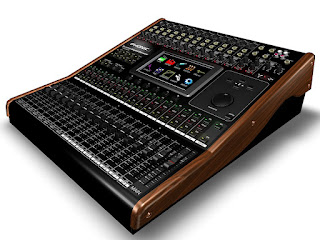Don't forget that Phonic is running it's Shout Out! contest all the way through to December. Check out Phonic's facebook fanpage for the competition entry page, rules and all the other info you may need to know.
All that's required to enter is you, a camera and an internet connection. Film a short tutorial or testimonial video based on Phonic products (you don't even need to own one if you're editing technique's good enough), and you could win a Phonic Summit Digital Mixer (the very theme of this blog), a Firefly 808 recording interface, a Powerpod 820 powered mixer, and a bunch of other prizes.
Videos are best uploaded to youtube or facebook, then entered to the video via the fanpage. There's no limit to how many times you can enter (just how many prizes you can win), and no limit to how many times you can vote for your own video (there's a cap per day, so get your friends and family involved).
Check out the competition page here.
Thursday, 16 September 2010
Thursday, 9 September 2010
Summit Reviewed!
There are already a few reviews for the Summit floating about. Australian-based Mixdown Magazine has reviewed the unit in their latest edition (September 2010). It received favourable remarks from the reviewer, who ended the review with: "The question is... do you want to make you[sic] recording process simpler, easier and higher quality? Then take a look at the Phonic Summit digital mixing console."
There are also a pair of reviews in the German publications Keys and Recording Magazin. As noted earlier this week, I don't understand German, but I'm assured they're very thorough. Check out the latest issues of these mags for details (and a full look at the reviews!)
We have some US-based reviews coming up. I'll keep you all updated on that.
There are also a pair of reviews in the German publications Keys and Recording Magazin. As noted earlier this week, I don't understand German, but I'm assured they're very thorough. Check out the latest issues of these mags for details (and a full look at the reviews!)
We have some US-based reviews coming up. I'll keep you all updated on that.
Wednesday, 8 September 2010
New Summit Video from Jay of US Music Fame
As of September 16th, this has been removed by US music. Hopefully we get a new one shortly.
Session Music Phonic Summit Video (German)
I don't understand German myself, but I'm sure this is a fantastic video.
www.session.de
Session Music
Hanauer Landstrasse 338,
60314 Frankfurt, Germany
www.session.de
Session Music
Hanauer Landstrasse 338,
60314 Frankfurt, Germany
Friday, 3 September 2010
Summit Concept Art Part 4
This is a pretty recent concept art (I think late last year). Really close to the home stretch, when we were finalizing the design. We actually had a few of these done up as working prototypes even.

We ended up changing the input channels to 16 mic/line (instead of having the 4 1/4" connectors without the XLR), and the general color scheme was altered. At the end of the day, the woodgrain acrylic looked pretty tacky. The red we went with goes well with the design and kind of suits the product.
Thursday, 2 September 2010
Summit Delay Function
 We don't tout it as much as we probably should, but the Summit Digital Mixer actually has an adjustable delay on every single input and output channel. That includes all 16 input channels, as well as the 8 multi outputs, the main outputs, and the control room outputs.
We don't tout it as much as we probably should, but the Summit Digital Mixer actually has an adjustable delay on every single input and output channel. That includes all 16 input channels, as well as the 8 multi outputs, the main outputs, and the control room outputs.To the left you can find an image of the delay function for a single input channel (four channels will be shown on screen at any one time). As you can see, there's an on button, as well as 3 controls for adjusting parameters. The "Time", of course, adjusts the delay time (up to 2 seconds), whereas the "Mix" determines the amount of your mix will be delayed. Finally, the "Feedback" determines how much of the signal will be fed back through to the channel (particularly useful for electric guitars!).
This is the case for input channels. Output channels, on the other hand, just let you adjust the delay time alone. This is all you need, however, as it allows users to compensate for the distance between speakers in larger setups. And don't forget the firmware updates mentioned a few weeks ago: the latest firmware has a new function that lets users change the adjustable parameter on the delay function between milliseconds, meters or feet. That takes a lot of the headache out of live setups!
Subscribe to:
Comments (Atom)





